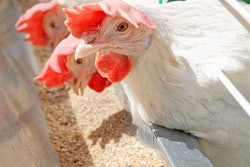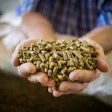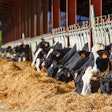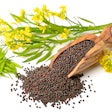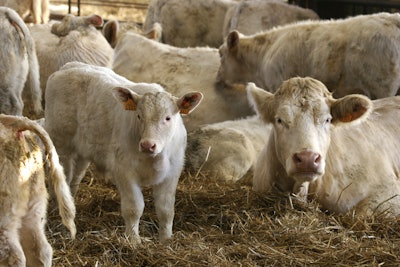
Flavoring agents may either be natural, such as garlic, anise and black cumin, or artificial, such as fruit extracts and chemical products, including vanillin, sodium glutamate, etc. The flavors are usually included in the diet at levels ranging from 0.5% to 1.5%. These levels may, however, be adjusted according to the type of animal, type of feed ingredient used in the ration, length of storage of feed, water quality, and disease outbreaks, all of which factors require special flavor treatments.
The use of feed flavors has been widely accepted, especially in ruminants, for two reasons.
First, there is a large number of taste buds situated on the dorsal surface of the tongue and in the pharynx and larynx. The number of taste buds in cattle is approximately 35,000 compared to 15,000 in sheep and goats, with only 24 in chickens, thereby allowing ruminants to have a better response to the feed flavors.
Second, the prolonged stay of feed in the mouth of the ruminant animal would certainly favor the solubility of flavoring agents, which contributes further to their effect on feed taste in the mouth and hence improve feed intake and animal performance.
Why feed flavors
Certain natural feedstuffs are relatively unsuitable for animals because they are not palatable. For example, animals tend to avoid concentrate feeds high in barley or rye in comparison with similar diets containing yellow corn. They also avoid diets containing unusual ingredients, such as fruit processing wastes, marine flora, etc. in comparison with respective diets providing the basic nutrients from natural feed materials.
Even with natural feeds known to be highly palatable, there may still be spoilage factors that adversely affect palatability due to the rancidity of fats, molding of sugars, and putrefaction of proteins, particularly when the feed is used after a long storage period. Deterioration of these important nutrients will produce flavors and odors that are not acceptable to the animals, representing a key factor in poor feed performance.
With silage-based diets, it may be essential to use feed flavors to mask the effects of alcohols formed during fermentation on palatability, especially when silage is made from high-moisture crops without wilting or from crops wilted under unfavorable field conditions.
Feed flavors and performance of calves
The intake of solid feed is vital to the calf for making the transition from a pre-ruminant to a functioning ruminant. An early introduction to starter feed is key to achieving optimal rumen development and reducing weaning duration and costs. A study was conducted to evaluate the effects of a vanilla flavor in starter feeds on pre-weaning and post-weaning calf performance. Results indicated that calves that are fed flavored starter weighed more at the weaning and the end of the experiment.
Further, the pre-weaning average daily gains increased significantly (+21%) compared with calves fed unflavored starters. The starter consumption was also higher (+19%), they met the weaning criteria at a younger age, and they had a shorter pre-weaning period by two to three days.
Feed flavors for dairy cattle
It is well known that dairy cows are very sensitive to changes in diet taste or flavor. Off-odors or bitter tastes could lead to low feed intakes, which will affect milk yield and impact farm performance. Studies have indicated that older ruminants, such as dairy cows, have a preference for citric tastes and aromas. The addition of flavors to the compound feed or total mixed rations (combined with a sweetener, if necessary) will ensure a homogeneous perception and mask possible changes in raw materials, unpalatable byproducts, and the bitter tastes of vitamins or minerals.
When using flavoring agents in dairy rations, the following points should be considered:
- Adding flavors should be done gradually, to reach the balance of their costs and milk yield, but the palatability of the feed materials is to be duly considered.
- Some flavor substances accumulate in cow body tissues, particularly in the fat, and are then transferred to the blood, and hence to the milk. The feed flavors should, therefore, be fed after milking and withheld from the cows four to five hours before milking.
Feed flavors for sheep and goats
Like other ruminants, sheep and goats are very sensitive to concentrate palatability. Preference tests under standard conditions in goats showed that flavors of unpalatable raw materials like fats, rapeseed meal, and urea can lower the palatability of compound concentrate feeds.
A study was conducted on lactating goats to determine whether diet palatability or feed preferences could influence the rate of intake. Results have shown that, with no physical presentation modifications, lower palatable diets strongly affected rates of intake. Sheep and goats have shown a preference for feeds treated with different flavoring agents. Adding an appreciated flavor to small ruminant feeds will enhance preference and feed intake, especially when low-palatable byproducts are used.
In the case where the animals are fed on unfamiliar feed, the use of flavoring agents may also be prompted regardless of the quality of feed material used. In one study, sheep were offered an unfamiliar feed (rice bran) in the presence or absence of a familiar grass odor or grass flavor. When offered the rice bran in the presence of grass juice odor or flavor, sheep ate a small amount on Day 1 and progressively increased their intake to 35–40 grams by Day 7. The control sheep did not ingest any rice bran until Day 5, then increased their intake to 35 grams by Day 11.
Feed flavors for poultry
Despite the low number of taste buds in chickens, they also appear to benefit from using flavoring agents in their diet. Some feed flavors were found to improve the taste of eggs and prevent slate or off-flavors that are usually detected after long storage periods, even under low temperature. The same holds with meat flavor. In one study, the average hedonic meat flavor scored 5.1 in birds receiving feed flavor shortly before slaughter, compared to a score of 4.5 for the control group.
Feed flavors also appear to have beneficial effects on reducing the formation of undesirable cholesterol in the carcass. Studies with garlic powder, for example, indicated that its addition to the diet has resulted in increased activity of the enzymes that convert cholesterol into bile acids, eventually being catabolized in the body so that a negligible amount is deposited in the carcass.
More recently, black cumin (Nigella sativa), a flavoring agent commonly used in bread and cheese making in some Arab countries, has been incorporated in rations for broiler chickens at 500 to 2,000 ppm. Results indicated that the addition of black cumin to the feed was effective in controlling infection of the carcass with bacterial species such as Salmonella, streptococci and staphylococci, due mainly to the presence of thymoquinone (20% to 25%) in the flavor.
Further work has shown that black cumin also plays an important role in alleviating heat stress in birds, improving immunity to diseases, such as Newcastle and coccidiosis, and in stimulating activities of the thyroid glands, thereby increasing the fertility of male chickens.
References are available upon request.



